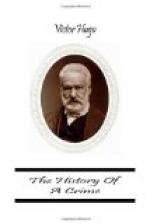Towards noon the centre of Paris began to grow agitated.
Our appeal to arms was first seen placarded on the Place de la Bourse and the Rue Montmartre. Groups pressed round to read it, and battled with the police, who endeavored to tear down the bills. Other lithographic placards contained in two parallel columns the decree of deposition drawn up by the Right at the Mairie of the Tenth Arrondissement, and the decree of outlawry voted by the Left. There were distributed, printed on gray paper in large type, the judgment of the High Court of Justice, declaring Louis Bonaparte attainted with the Crime of High Treason, and signed “Hardouin” (President), “Delapalme,” “Moreau” (of the Seine), “Cauchy,” “Bataille” (Judges). This last name was thus mis-spelt by mistake, it should read “Pataille.”
At that moment people generally believed, and we ourselves believed, in this judgment, which, as we have seen, was not the genuine judgment.
At the same time they posted in the populous quarters, at the corner of every street, two Proclamations. The first ran thus:—
“TO THE PEOPLE.
“ARTICLE III.[10]
“The Constitution is confided to
the keeping and to the patriotism of
French citizens. Louis NAPOLEON is
outlawed.
“The State of Siege is abolished.
“Universal suffrage is re-established.
“LONG LIVE THE REPUBLIC.
“To ARMS!
“For the United Mountain.
“The Delegate, VICTOR HUGO.”
The second ran thus:—
“INHABITANTS OF PARIS.
“The National Guards and the People
of the Departments are marching on
Paris to aid you in seizing the TRAITOR,
Louis Napoleon BONAPARTE.
“For the Representatives of the People,
“VICTOR HUGO, President.
“SCHOELCHER, Secretary.”
This last placard, printed on little squares of paper, was distributed abroad, says an historian of the coup d’etat, by thousands of copies.
For their part the criminals installed in the Government offices replied by threats: the great white placards, that is to say, the official bills, were largely multiplied. On one could be read:—




